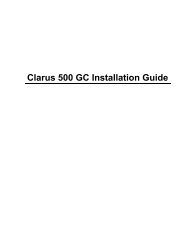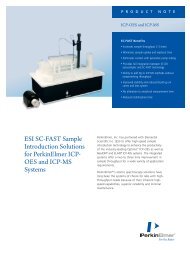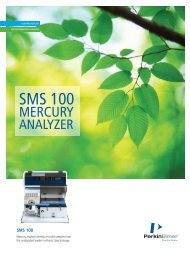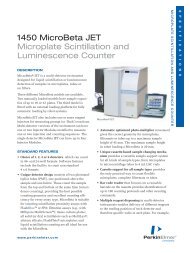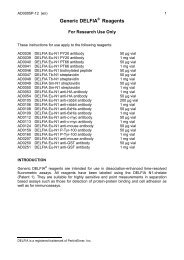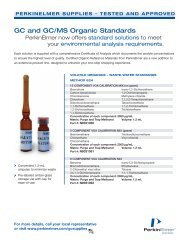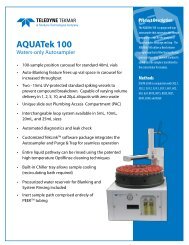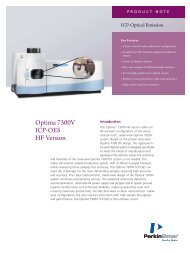HT Protein Charge Variant Kit User Guide - PerkinElmer
HT Protein Charge Variant Kit User Guide - PerkinElmer
HT Protein Charge Variant Kit User Guide - PerkinElmer
You also want an ePaper? Increase the reach of your titles
YUMPU automatically turns print PDFs into web optimized ePapers that Google loves.
<strong>HT</strong> <strong>Protein</strong> <strong>Charge</strong> <strong>Variant</strong> <strong>Kit</strong> <strong>User</strong> <strong>Guide</strong><br />
Troubleshooting<br />
Why don’t I see a profile for my sample?<br />
1. The running buffer pH may be too high or the chosen<br />
assay type may be too short: Try a longer assay<br />
and/or a lower pH.<br />
2. The plate well may contain air bubbles or not enough<br />
sample: The sipper may not be reaching the sample<br />
due to bubbles or low volume. Verify that there is<br />
sufficient sample volume to reach the sipper. To<br />
eliminate bubbles, centrifuge the sample plate for 1<br />
minute at 1000rpm before starting the run.<br />
Alternatively, manually dislodge the bubble using a<br />
pipette tip. Rerun these sample wells.<br />
3. The chip sipper may be clogged: Take the LabChip<br />
out of the instrument; carefully insert the sipper into<br />
the pipette tip attached to the vacuum that was used<br />
to aspirate the wells during chip preparation, until the pipette tip reaches the glue bead. With vacuum<br />
running, hold chip in place until several beads of liquid have emerged from the end of the sipper. Place<br />
chip in instrument and restart run.<br />
Why is the signal of my sample low?<br />
1. The Dye Mixture may have been left at room<br />
temperature for too long: The Dye Mixture should be<br />
used immediately (begin dispensing within 5 minutes<br />
of mixing with N,N-dimethylformamide). Extended<br />
incubation of the mixture at room temperature will<br />
cause degradation of the dye and decrease the<br />
amount of dye that can label the sample.<br />
2. The salt and/or excipient content of the sample may<br />
be too high: Higher conductivity of the sample<br />
typically results in less field amplified stacking of the<br />
sample during on-chip injection. Try desalting the<br />
sample before or after the labeling reaction.<br />
Alternatively, if there are high concentrations of<br />
amine-containing buffer or excipient present, then the<br />
signal of the mAb may decrease through competition for dye molecules during labeling.<br />
3. The mAb sample concentration may be too low. The preferred range of input concentration is 0.5 - 10<br />
mg/mL, and the optimal concentration is 2 mg/mL. Some samples, depending on the number of charge<br />
variants, give lower signals than others; make sure that the sample concentration is ≥ 2 mg/mL.<br />
Why are there extra peaks in the profile of my<br />
sample?<br />
Excipients with amines, such as histidine, can be labeled by the <strong>HT</strong><br />
<strong>Protein</strong> <strong>Charge</strong> <strong>Variant</strong> dye and appear in the profile as extra peaks.<br />
To remove these peaks desalt the sample before or after the labeling<br />
reaction.<br />
_________________________________________________________________________________________<br />
Caliper - a <strong>PerkinElmer</strong> Company Page 11 of 18 PN: CLS135474 Rev. 02<br />
68 Elm Street<br />
Hopkinton, MA 01748-1668<br />
1-877-LABCHIP (1-877-522-2447)





